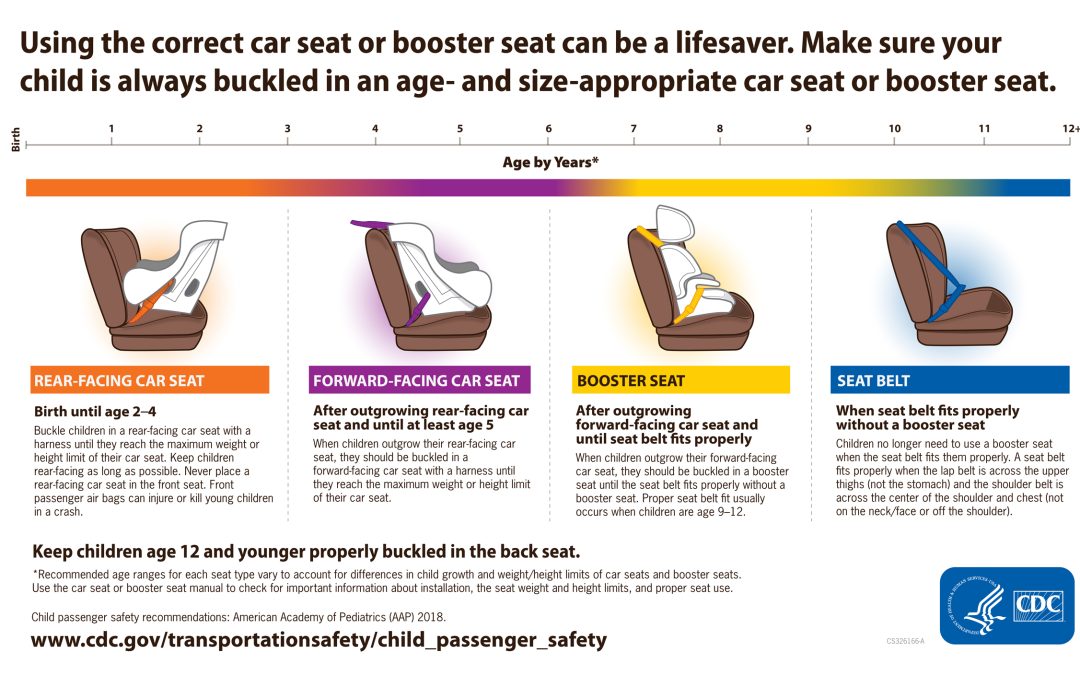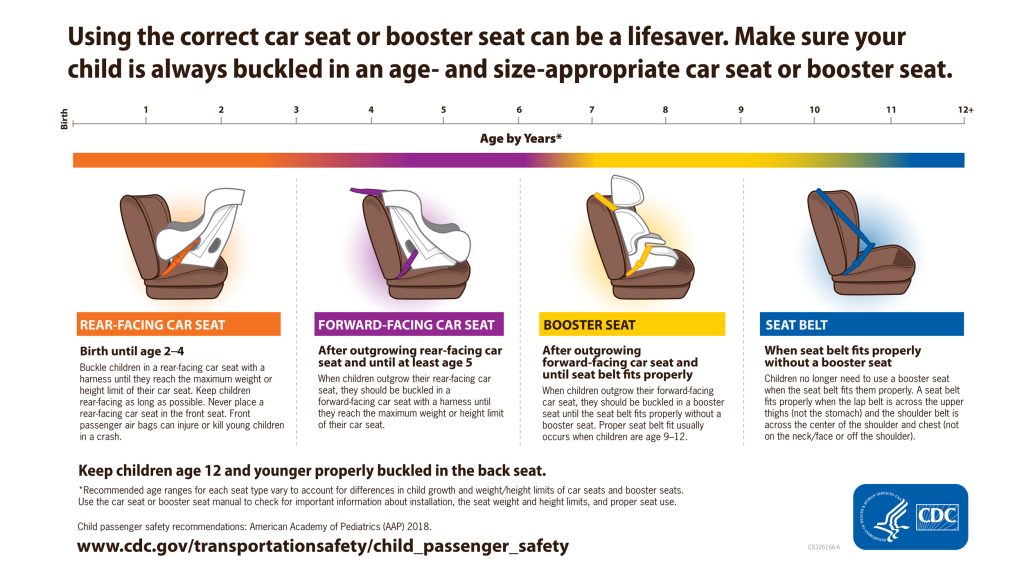In 2019, 608 child passengers age 12 and younger died in motor vehicle crashes,1 and more than 91,000 were injured.2 Of the children 12 and younger who died in a crash (for whom restraint use was known), 38% were not buckled up.1 Parents and caregivers can make a lifesaving difference by checking whether their children are properly buckled on every trip.
- Of the children who died in a crash:
- Restraint use (like car seat, booster seat, or seat belt use) varies by age. In 2019, 43% of 8–12-year-olds were not buckled up, compared to 41% of 4–7-year-olds and 27% of children less than 4 years old (for whom restraint use was known).1
- Black and Hispanic children have higher proportions of unrestrained child deaths compared with White children. A study of data from 2009–2010 indicated that 45% of Black children and 46% of Hispanic children were not buckled up, compared with 26% of White children (among children 12 and younger).3
- Alcohol-impaired driving is a threat to the safety of child passengers. In 2019, 23% of child passenger deaths among children age 14 years and younger in the United States involved alcohol-impaired driving (blood alcohol concentration ≥0.08 g/dL); 64% of the time, it was the child’s own driver who had been drinking.1
- Among children who died in alcohol-impaired driving crashes, a higher proportion of those riding with impaired drivers were unrestrained (58%) compared with those riding with sober drivers (37%).1
- Restraint use among young children often depends on the driver’s seat belt use. In 2019, 67% of fatally injured children riding with unbelted drivers were also unrestrained (based on known restraint use).1
- Child restraint systems are often used incorrectly. An estimated 46% of car seats and booster seats are misused in a way that could reduce their effectiveness.4,5
- Of the children who died in a crash:
- Restraint use (like car seat, booster seat, or seat belt use) varies by age. In 2019, 43% of 8–12-year-olds were not buckled up, compared to 41% of 4–7-year-olds and 27% of children less than 4 years old (for whom restraint use was known).1
- Black and Hispanic children have higher proportions of unrestrained child deaths compared with White children. A study of data from 2009–2010 indicated that 45% of Black children and 46% of Hispanic children were not buckled up, compared with 26% of White children (among children 12 and younger).3
- Alcohol-impaired driving is a threat to the safety of child passengers. In 2019, 23% of child passenger deaths among children age 14 years and younger in the United States involved alcohol-impaired driving (blood alcohol concentration ≥0.08 g/dL); 64% of the time, it was the child’s own driver who had been drinking.1
- Among children who died in alcohol-impaired driving crashes, a higher proportion of those riding with impaired drivers were unrestrained (58%) compared with those riding with sober drivers (37%).1
- Restraint use among young children often depends on the driver’s seat belt use. In 2019, 67% of fatally injured children riding with unbelted drivers were also unrestrained (based on known restraint use).1
- Child restraint systems are often used incorrectly. An estimated 46% of car seats and booster seats are misused in a way that could reduce their effectiveness.4,5
- The Community Preventive Services Task Force recommends child restraint laws to increase restraint use and decrease injuries and deaths among child passengers, based on strong evidence of effectiveness.10
- Child restraint laws require children riding in vehicles to use approved restraint devices such as car seats, booster seats, or seat belts that are appropriate for their age, height, and weight.10,11
- Strengthening current laws with booster seat provisions that require children who have outgrown car seats to use booster seats until at least age 9 helps reduce injuries and deaths.12–16
- Children age 4–8 years in states with booster seat laws were over four times as likely to be using age-appropriate restraints and were 20% less likely to die than children in states without booster seat laws.12
- A study among children involved in crashes found that restrained children were 66% more likely to be buckled in appropriate restraints if their state law followed best practice recommendations.13
- Observed booster seat use among children age 4–7 years increased by 19 percentage points after booster seat laws were implemented in Milwaukee County, Wisconsin.14
- The death rate among 7-year-olds was 25% lower for the children in states with booster seat laws compared to states without booster seat laws.15
- The rate of children using car seats and booster seats increased nearly three times in five states that increased the booster seat use age requirement to 7 or 8 years. The rate of children who sustained fatal or incapacitating injuries decreased by 17% in these states.16
- Car seat distribution plus education programs also are recommended for increasing restraint use.10,17 Distribution plus education programs help parents and caregivers obtain new, unused car seats and learn how to properly use and install them.10,17 These programs often include hands-on demonstrations, which can help increase proper use and installation.
- Short-term, high-visibility enforcement of child restraint laws are similar to those used for seat belt use (such as Click It or Ticket). Effective programs are short-term, highly visible in the community, and advertised widely in the media.11
- Incentive and education programs reward parents or children with coupons or other prizes for correctly using car seats. Programs offer print materials, videos, or other instructional aids for parents and caregivers.11
CDC provides guidance to ensure children are properly buckled in a car seat, booster seat, or seat belt— whichever is appropriate for their age, height, and weight.
- Rear-facing car seat: Birth until age 2–4.
Infants and toddlers should be buckled in a rear-facing car seat with a harness, in the back seat, until they reach the maximum weight or height limit of their car seat. This offers the best possible protection. Check the car seat manual and labels on the car seat for weight and height limits. Never place a rear-facing car seat in the front seat. Front passenger air bags can injure or kill young children in a crash.
- Forward-facing car seat: After outgrowing the rear-facing car seat and until at least age 5.
When children outgrow their rear-facing car seats, they should be buckled in a forward-facing car seat with a harness, in the back seat. They should stay in the forward-facing car seat until they reach the maximum weight or height limit of this seat. Check the car seat manual and labels on the car seat for weight and height limits. - Booster seat: After outgrowing the forward-facing car seat and until the seat belt fits properly.
When children outgrow their forward-facing car seat, they should be buckled in a belt-positioning booster seat with a seat belt, in the back seat, until the seat belt fits properly without a booster seat. A seat belts fits properly when the lap belt is across the upper thighs (not the stomach) and the shoulder belt is across the center of the shoulder and chest (not on the neck/face or off the shoulder). This typically does not occur until children are age 9–12. - Seat belt: When the seat belt fits properly without a booster seat.
Children no longer need to use a booster seat when the seat belt fits them properly. A seat belt fits properly when the lap belt is across the upper thighs (not the stomach) and the shoulder belt is across the center of the shoulder and chest (not on the neck/face or off the shoulder). This typically does not occur until children are age 9–12. Seat belt fit can vary by vehicle so check belt fit in all vehicles to make sure the child no longer needs to use a booster seat. It could be that a child might need a booster seat in one vehicle but not another. Keep children properly buckled and in the back seat through age 12 for the best possible protection. - Install and use car seats & booster seats properly.
Install and use car seats and booster seats according to the car seat/booster seat manual, or get help installing them from a certified child passenger safety technicianexternal icon. - Find a child passenger safety technicianexternal icon.
- Don’t seat children in front of an air bag.
Air bags can kill young children riding in the front seat. Never place a rear-facing car seat in front of an air bag. - Buckle children in the back seat.
Properly buckle all children age 12 and younger in the back seat. - Always buckle older children who use booster seats or seat belts with a lap and shoulder belt. Both the lap and shoulder belt are needed for proper protection.
- Buckle children in the middle of the back seat.
Properly buckle children in the middle seating position of the back seat when possible, because it is the safest position in the vehicle.18- If the middle seating position contains only a lap belt, older children using booster seats or seat belts should sit in a different seating position in the back seat where they can use both a lap and shoulder belt.
- Most rear-facing and forward-facing car seats can be safely installed in the middle seating position using the lap belt only, so younger children using these types of seats can be safely positioned in the middle.
- Use proper restraints on every trip.
Buckle children in car seats, booster seats, or seat belts on every trip—no matter how short the trip. - Parents and caregivers: Always wear a seat belt.
Set a good example by always using a seat belt.


